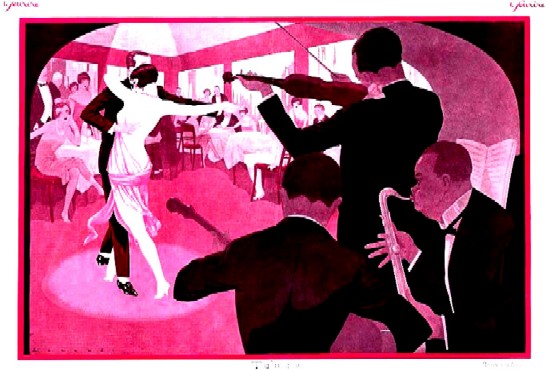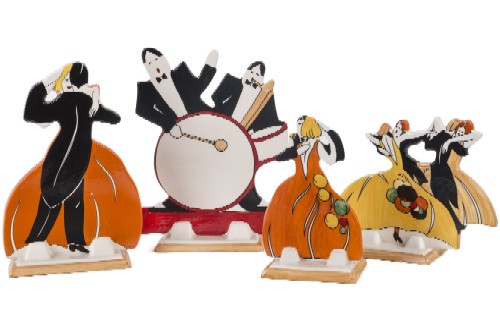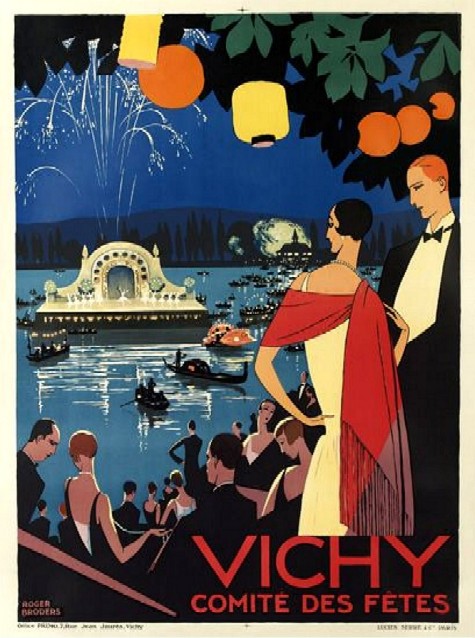
Jazz Moderne - An Art Deco Subcategory
The era of the 20s and 30s is often referred to as the 'Jazz Age' and the decorating style associated with it is sometimes called Jazz Modern or Jazz Style. In the broadest sense, this embraces all of the 1920s, 30s and even part of the 40s. So it isn't a very precise term, but it is appropriate to talk a little about the link between the music often associated with the bars and American speakeasies of the period and this particular phrase.

Jazz Age, Tango, Fabius Lorenzi, 1926, Art Deco Society of Los Angeles
The New York Times explains,
Technically, the term art deco — the name derives from the 1925 Paris Exposition Internationale des Arts Decoratifs, a major force in popularizing the style — refers only to an early phase of the style, and scholars often prefer to call the architecture of the entire period 'jazz modern' or 'art moderne.'
The style has complicated, almost contradictory, origins. It was a cubist influenced attempt to symbolize the modern age, to appear sleek and modern, and yet its forms were also clearly influenced by Aztec art, Egyptian art and art nouveau.
Instead of eliminating ornament altogether, art deco buildings chose a new type of ornament which romantically symbolized the machine age with sculpture, painting and streamlined and zigzagged forms. But the buildings were not really new in any technological way.
The style never quite fit into critics' systems—it was neither part of the spare, orthodox modernism of the Period, nor of historically eclectic architecture. Art deco designers insisted upon calling their style modern, and critics generally reacted by calling it vulgar.
(Paul Goldberger, "Style Moderne Kitsch or Serious - Is in Vogue", New York Times, January 31, 1974, p. 35)
This helps to refine the term and its meaning

'Age of Jazz' Figures by Clarice Cliff, 1996 Versions of 1930 Bizarre Ware #s 435,
433, 434,
Wedgewood Reproductions, Invaluable
vis-a-vis design. First, he does not call the whole period Art Deco, referring to it instead as Art Moderne or Jazz Modern. Second, he defines only the 1920s as 'Art Deco'. Third, it delineates two forms - 'zigzag' and 'streamline'. The term 'Zigzag Moderne' is sometimes used to refer to the style of the 1920s and 'Streamline Moderne' to the 1930s. It is curious that Goldberger suggests that the whole period can be called 'Art Moderne'. Many people use 'Art Moderne' interchangeably with 'Streamline Moderne' which the term he suggests for the 1930s style.
Marc Schenker proposes an entirely different explanation for the association between jazz and Art Deco in a blog at the Creative Market website. He links the style of the time with its music which he calls 'Jazz Style'. Schenker explains that it is "a very real take on design and aesthetics. Whereas the musical genre is, of course, intangible, its promoters and fans still had to be able to visually represent it to communicate its sounds and ideals. That's where designers and artists come into the picture, taking the intangible values of this aesthetic and giving it its own visual language." (Marc Schenker, "Design Trend Report: Jazz Style," April 17., 2024)
Schenker goes on to carefully explain that although the influence of Art Deco can be found in his 'Jazz Style', they are not the same. To explain this more thoroughly, he lists a number of characteristics which he feels represent Jazz Style. (Being associated with music, several of these are a bit too esoteric to associate with interior design.) His Jazz Style characteristics are:

Vichy Festival Committee Poster, Roger Broders, 1928, Swann Auction Galleries
- Stylization (of typography, illustrations, etc.)
- Evocative qualities (of times gone by, through vintage elements)
- Sleekness
- Suaveness
- Good use of color contrast
- The presence of golden hues and tones
- Neutral colors, in particular, black
- Musical and simple shapes and icons
- Diverse typefaces (slabs, scripts, sans serifs, etc.)
- Geometric figures and shapes
- Streamlined shapes
- Silhouettes
- Monochromatic (especially black and white) elements
- Conservative (at least in fashion)
Stylization and sleekness kind of go together in my mind and can be found in both Streamline and Deco. They can be seen in posters from the period, some of which are included here. Geometric figures and shapes as well as simple shapes and icons appear in both 1920s Art Deco and 30s Streamline Moderne styles. 'Silhouettes' are very simplified shapes which could be seen as a sort of streamlining. (To be fair, they are different.)
Several of the other characteristics he lists fit best with 1920s Art Deco while others fit better with 1930s Streamline Moderne. Parsing the different styles out produces:
- 1920s Art Deco:- Golden hues and tones, Monochromatic elements and color contrasts. (Streamline typically makes use of more harmonious colors.)
- 1930s Streamline Moderne:- Neutral colors, Streamlined shapes
I don't quite know how to include the concept of 'suaveness' into interior design, although I can see how it would fit jazz music. Conservative fashion is another unusual one, although I suggest thinking of it as a form of reduction or elimination of excessive decoration, something the Modernists trumpeted (hah) and which fit into both the 1920s and 1930s. Compare this with the ornate Art Nouveau style of the 1900s and 1910s.
Reference Not Mentioned Above:
"Art Deco and Jazz Modern Style Furniture", Foxwood Restorations, gathered 8/4/24
Original Facebook Group Posting